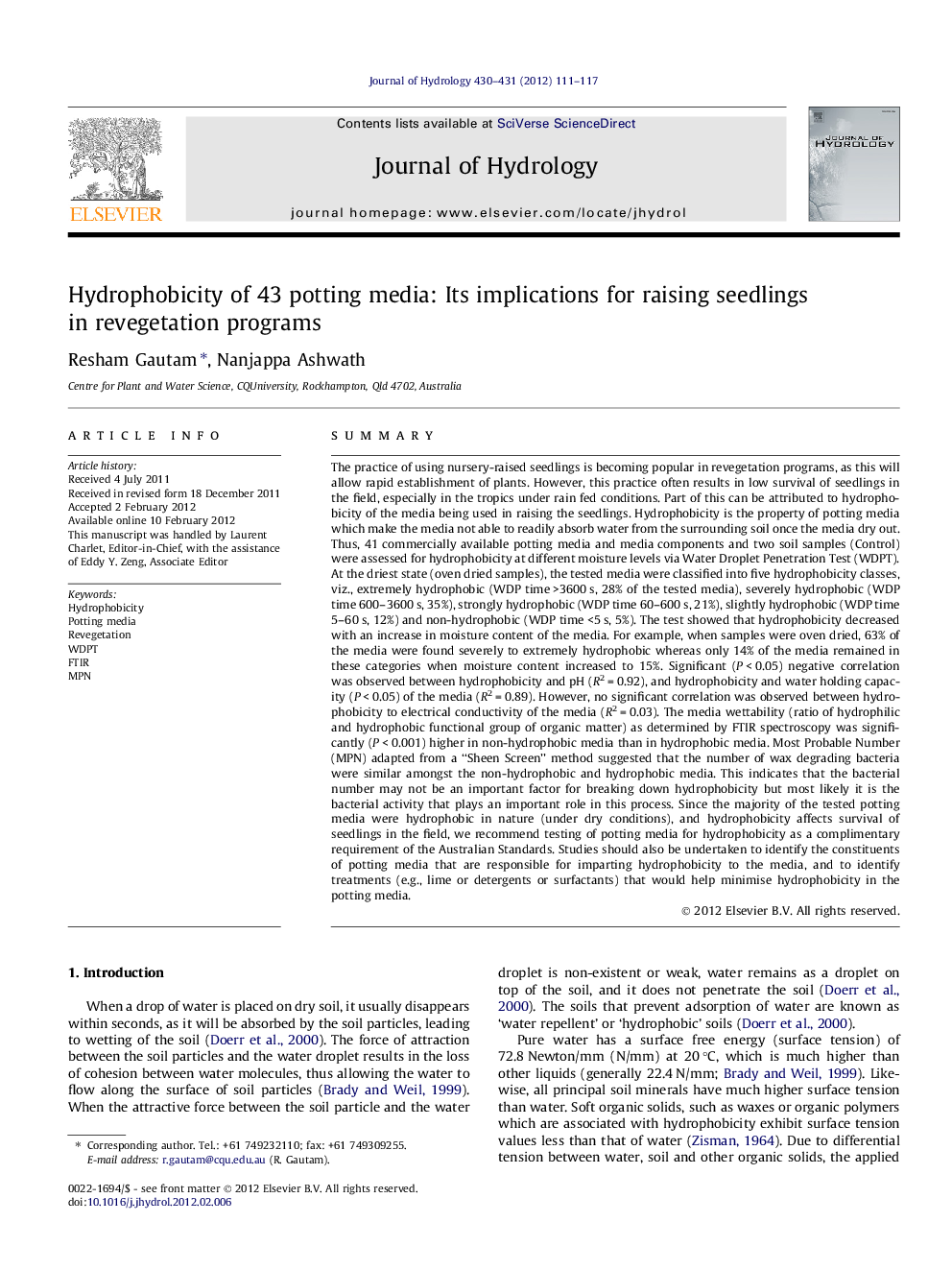| کد مقاله | کد نشریه | سال انتشار | مقاله انگلیسی | نسخه تمام متن |
|---|---|---|---|---|
| 4577065 | 1629996 | 2012 | 7 صفحه PDF | دانلود رایگان |

SummaryThe practice of using nursery-raised seedlings is becoming popular in revegetation programs, as this will allow rapid establishment of plants. However, this practice often results in low survival of seedlings in the field, especially in the tropics under rain fed conditions. Part of this can be attributed to hydrophobicity of the media being used in raising the seedlings. Hydrophobicity is the property of potting media which make the media not able to readily absorb water from the surrounding soil once the media dry out. Thus, 41 commercially available potting media and media components and two soil samples (Control) were assessed for hydrophobicity at different moisture levels via Water Droplet Penetration Test (WDPT). At the driest state (oven dried samples), the tested media were classified into five hydrophobicity classes, viz., extremely hydrophobic (WDP time >3600 s, 28% of the tested media), severely hydrophobic (WDP time 600–3600 s, 35%), strongly hydrophobic (WDP time 60–600 s, 21%), slightly hydrophobic (WDP time 5–60 s, 12%) and non-hydrophobic (WDP time <5 s, 5%). The test showed that hydrophobicity decreased with an increase in moisture content of the media. For example, when samples were oven dried, 63% of the media were found severely to extremely hydrophobic whereas only 14% of the media remained in these categories when moisture content increased to 15%. Significant (P < 0.05) negative correlation was observed between hydrophobicity and pH (R2 = 0.92), and hydrophobicity and water holding capacity (P < 0.05) of the media (R2 = 0.89). However, no significant correlation was observed between hydrophobicity to electrical conductivity of the media (R2 = 0.03). The media wettability (ratio of hydrophilic and hydrophobic functional group of organic matter) as determined by FTIR spectroscopy was significantly (P < 0.001) higher in non-hydrophobic media than in hydrophobic media. Most Probable Number (MPN) adapted from a “Sheen Screen” method suggested that the number of wax degrading bacteria were similar amongst the non-hydrophobic and hydrophobic media. This indicates that the bacterial number may not be an important factor for breaking down hydrophobicity but most likely it is the bacterial activity that plays an important role in this process. Since the majority of the tested potting media were hydrophobic in nature (under dry conditions), and hydrophobicity affects survival of seedlings in the field, we recommend testing of potting media for hydrophobicity as a complimentary requirement of the Australian Standards. Studies should also be undertaken to identify the constituents of potting media that are responsible for imparting hydrophobicity to the media, and to identify treatments (e.g., lime or detergents or surfactants) that would help minimise hydrophobicity in the potting media.
► The majority of the tested potting media were found hydrophobic.
► The hydrophobicity was associated with low pH of the media.
► Low water holding capacity contributed to higher hydrophobicity.
► Wax degrading microbial population did not vary with the hydrophobicity.
► The increased wettability of the media decreases hydrophobicity.
Journal: Journal of Hydrology - Volumes 430–431, 2 April 2012, Pages 111–117